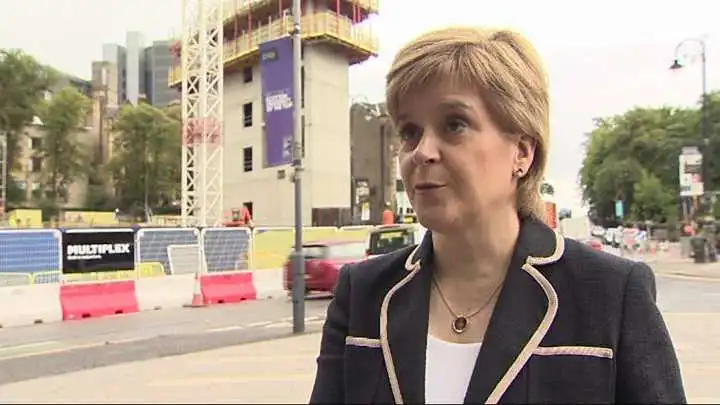
Speaking at Glasgow University Nicola Sturgeon says the reduction in Scotland's deficit is "positive"
Scotland's public finances have continued to show some improvement over the past year, according to Scottish government statistics.
The Government Expenditure and Revenue Scotland (Gers) report said the country spent £13.4bn more than it raised in taxes in the past financial year.
The deficit as a percentage of the country's GDP dropped from 8.9% to 7.9%still four times higher than the UK.
The UK's spending deficit dropped by £6.4bn to £39.4bn in 2017/18.
This was the lowest figure since since 2007, and the equivalent of 1.9% of the UK's GDP.
The Gers figures have become a key battleground in the debate over Scottish independence in recent years.
Scotland had a relatively stronger fiscal position than the UK in 2010/11, but since then the position has been reversedlargely as a result of the collapse in the oil price.
-
$57.4 Per barrel in 2017-18
-
$48.5 Per barrel in 2014-15
-
$107.6 Per barrel in 2013-14
PA
The latest statistics estimated that Scotland's total public sector revenue rose by about £3bn to £60bn in 2017/18, of which £1.3bn was from the North Sea oil and gas industry.
This was higher than the £266m of revenue from the North Sea in the previous yearbut well below the £8bn the offshore industry generated in 2011/12.
Scotland's share of total UK revenue has also fallen in recent years from a peak of 9.7% in 2008/09, and currently stands at 8.0% of the UK total.
Total expenditure by the Scottish government, UK government, and all other parts of the public sector in Scotland was said to have increased put at £73.4bn, which was equivalent to 9.3% of total UK public sector expenditure.
Other key statistics from the report include:
- Including North Sea oil revenue, Scotland's public sector raised the equivalent of £11,052 per person last year£306 per person less than the UK average
- Scotland's expenditure per person was £13,530, which is £1,576 per person higher than the UK average
Last year's report estimated that Scotland's spending deficit had been £13.3bn, or the 8.3% GDP, in 2016/17.
But these figures have now been revised upwards to £14.5bn and 8.9% of GDP.
First Minister Nicola Sturgeon welcomed the latest figures, which she said provided further evidence that the country's economy was "on the right trajectory" despite the "limited powers" at the Scottish government's disposal.
And she rejected the suggestion that higher public spending north of the border despite the deficit was a "persuasive argument for the union".
Ms Sturgeon added: "If we look at the situation in Scotland within the UK over a longer period of time, this notion that Scotland is somehow subsidised, I think, simply does not stand up to scrutiny."
But the UK government's Scottish secretary, David Mundell, said it was concerning that Scotland's deficit as a share of GDP remained four times that of the UK's.
He said: "These figures confirm that being part of a strong United Kingdomthe 5th largest economy in the worldis worth nearly £1,900 for every single person in Scotland, which supports vital public services.
"Simply put, Scotland contributed 8% of UK tax, and received more than 9% of UK spending for the benefit of families across the country."
Scottish Labour leader Richard Leonard said the figures showed that "the SNP's plans for independence would mean unprecedented levels of austerity for Scotland".
Gers was described as the "authoritative publication on Scotland's public finances" in the Scottish government's White Paper on independence ahead of the 2014 referendum.
The report is compiled by statisticians working for the Scottish government's chief economic adviser, and is free from political interference.
The Scottish government has published a list of answers to frequently asked questions about how Gers is compiled here.
- Context to the figuresThe gap between Scottish and UK spending per person has increased since 2014-15. This is in part due to Scottish government capital borrowing powers which began in 2015-16. In addition, water and sewerage services are provided by the public sector in Scotland, and therefore included in Scottish expenditure. In England and Wales they are operated by the private sector and therefore excluded from UK expenditure.